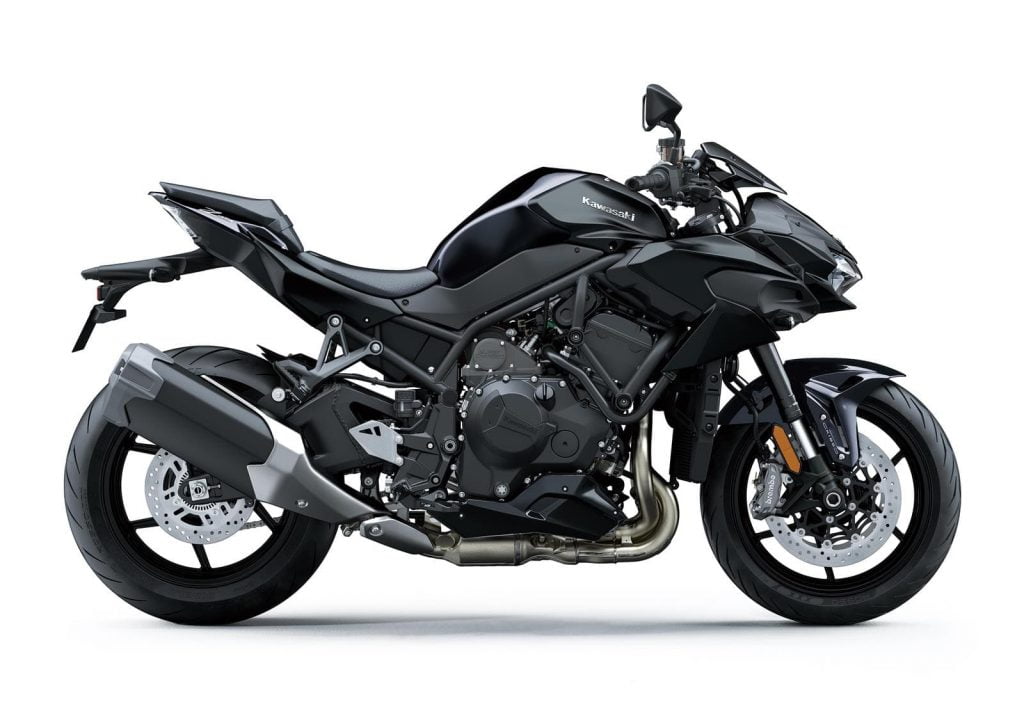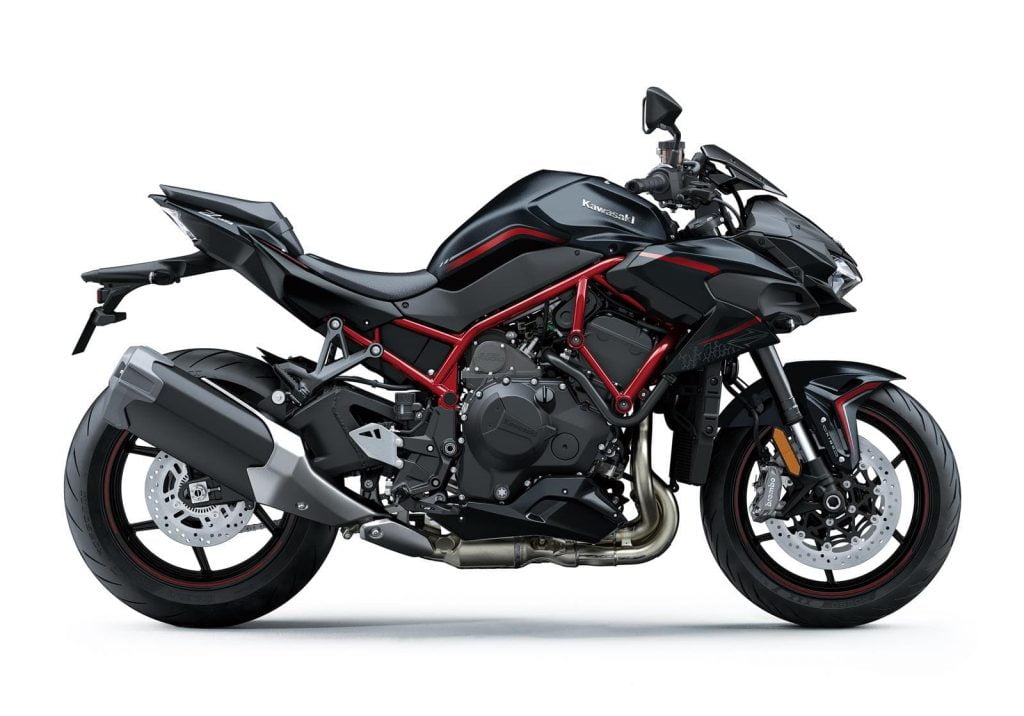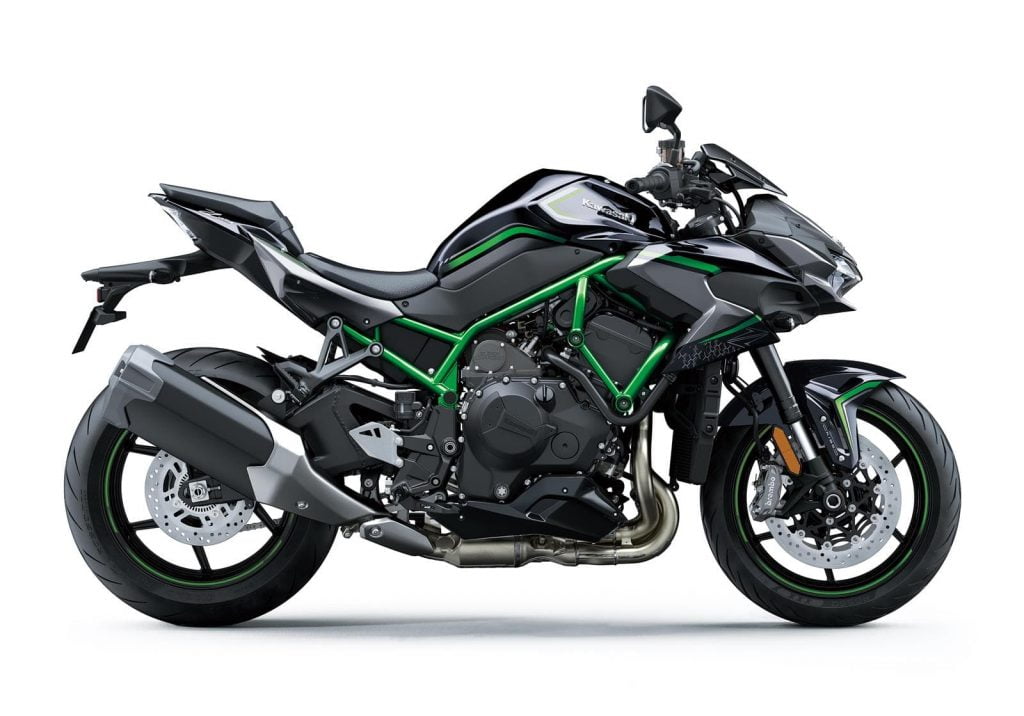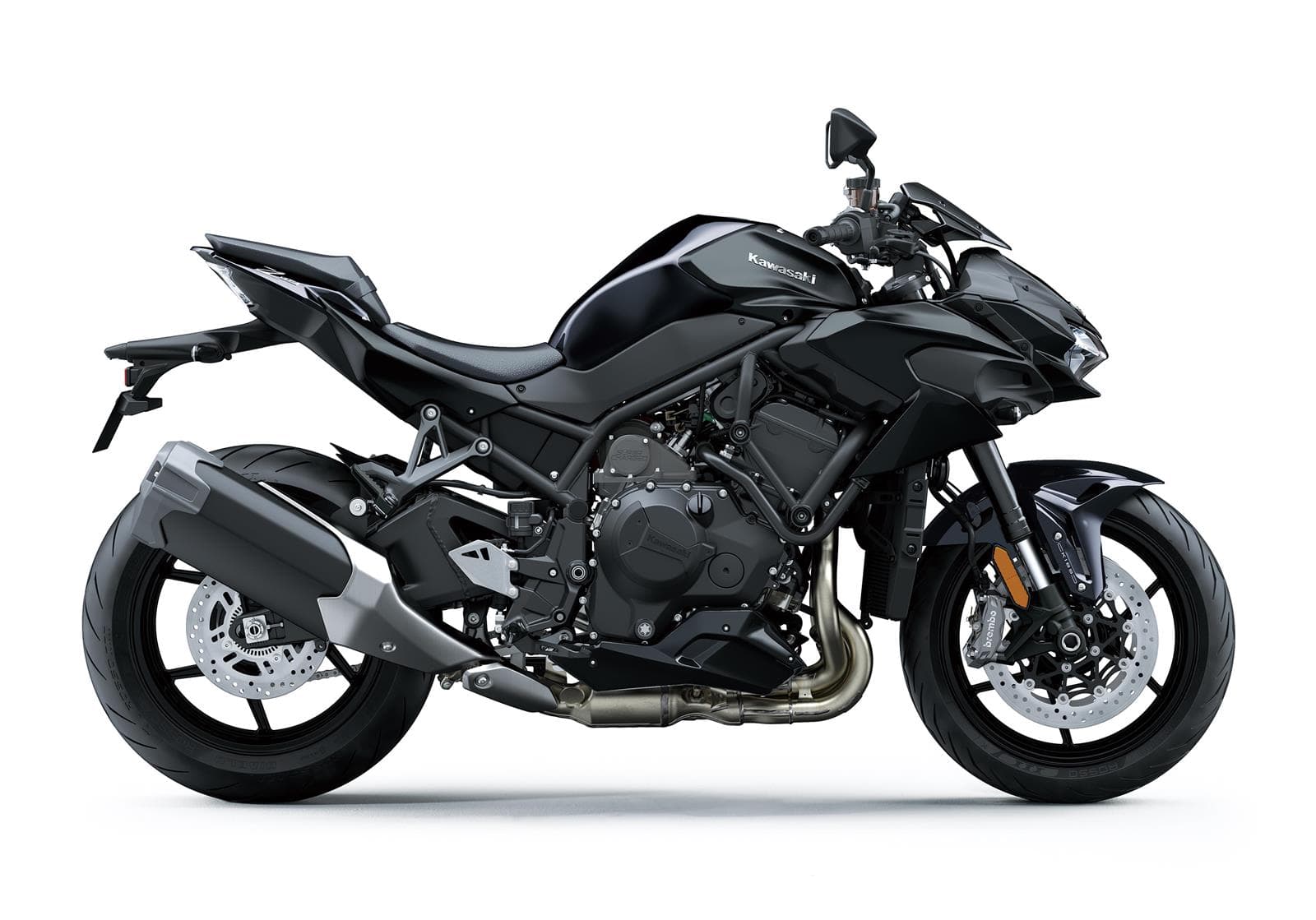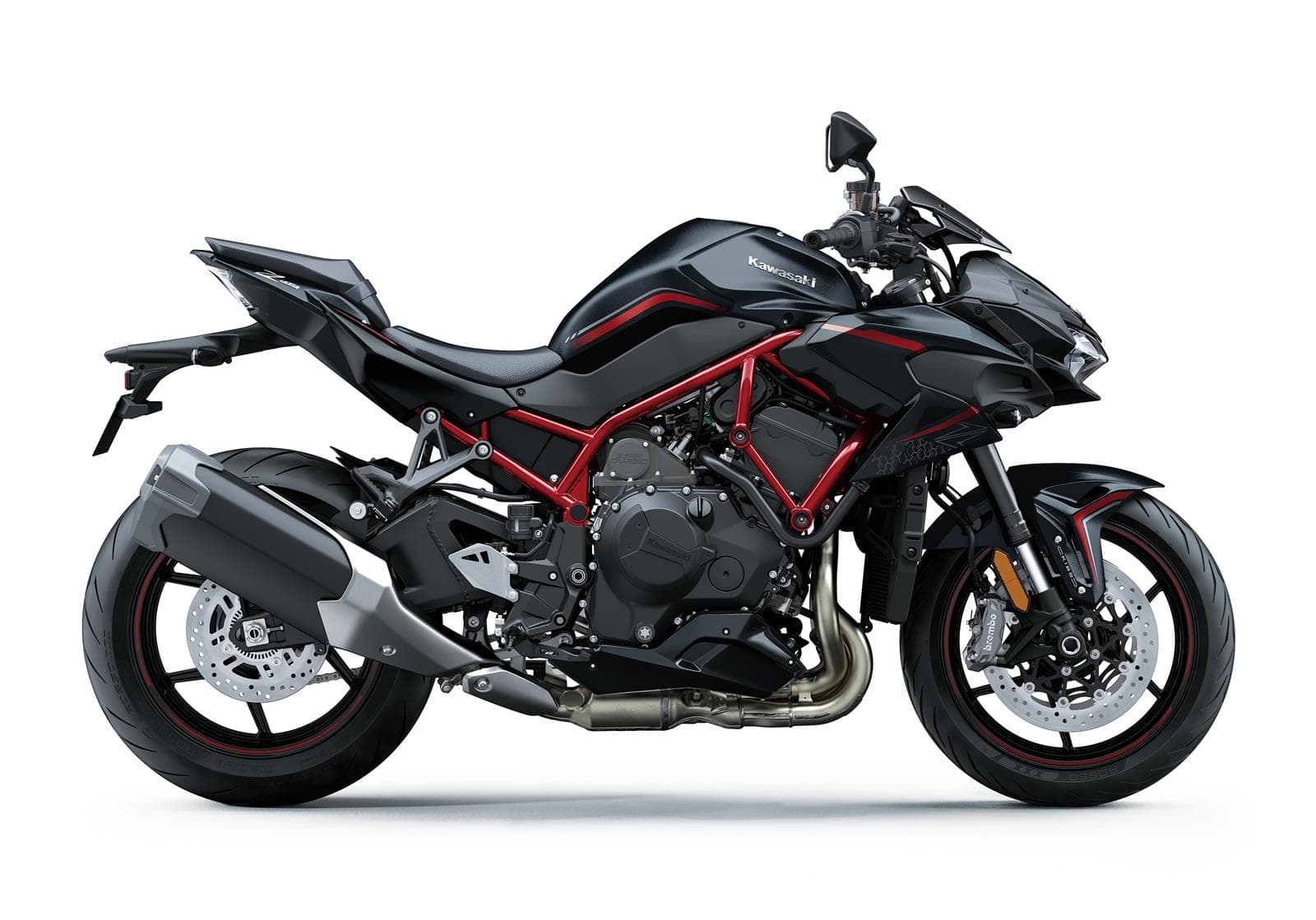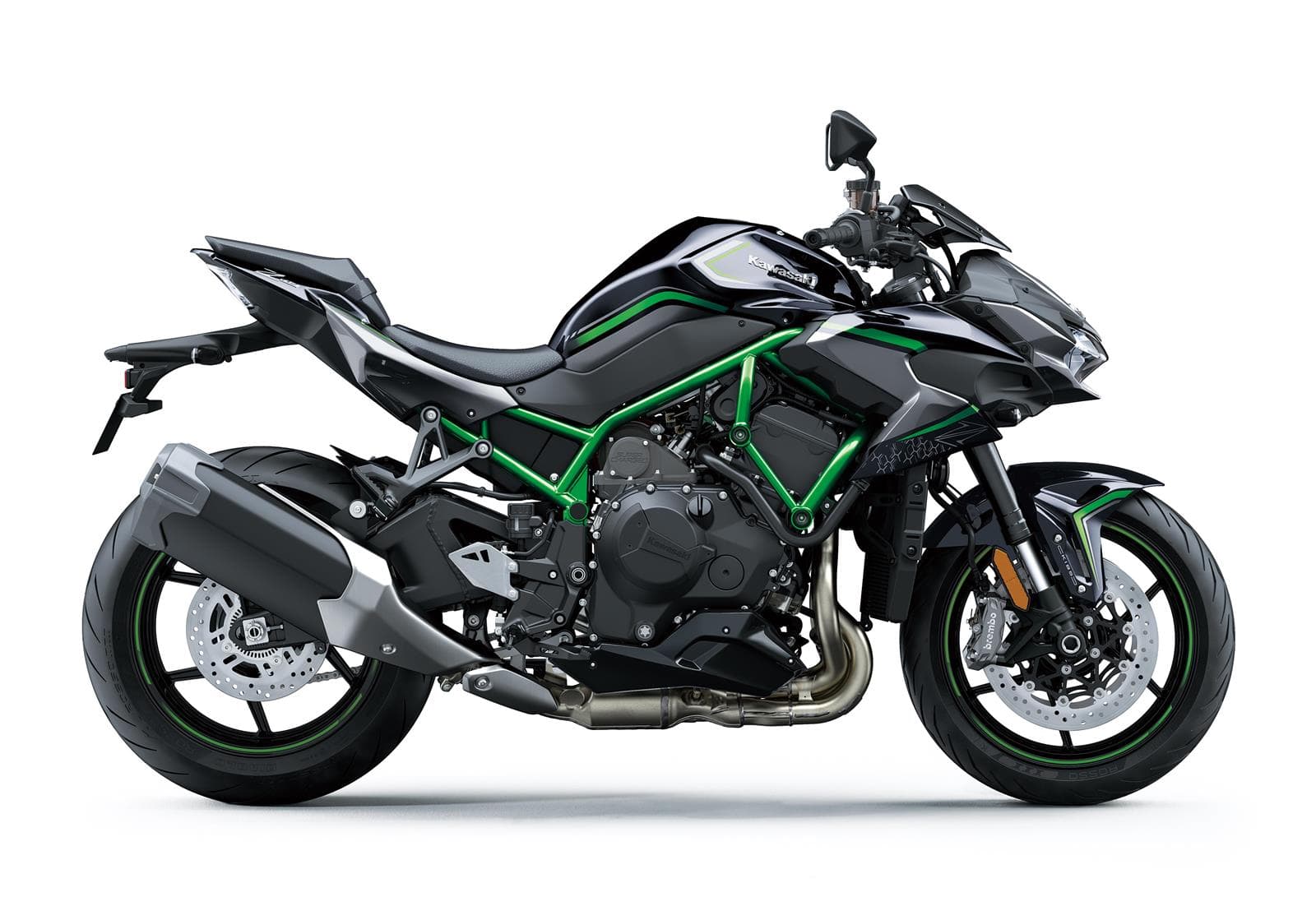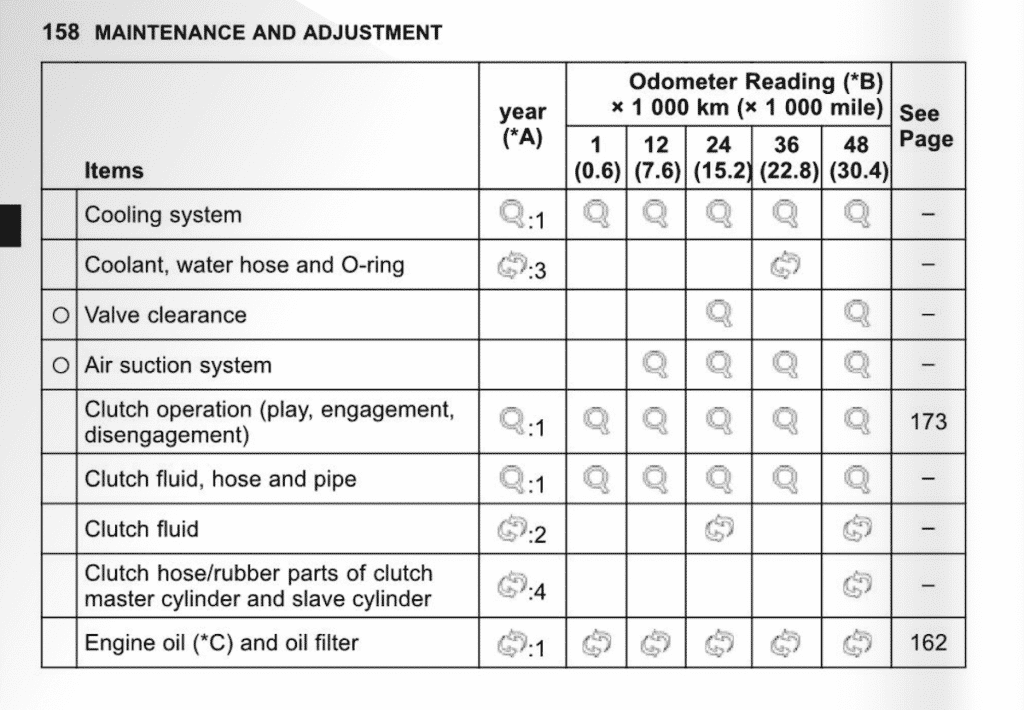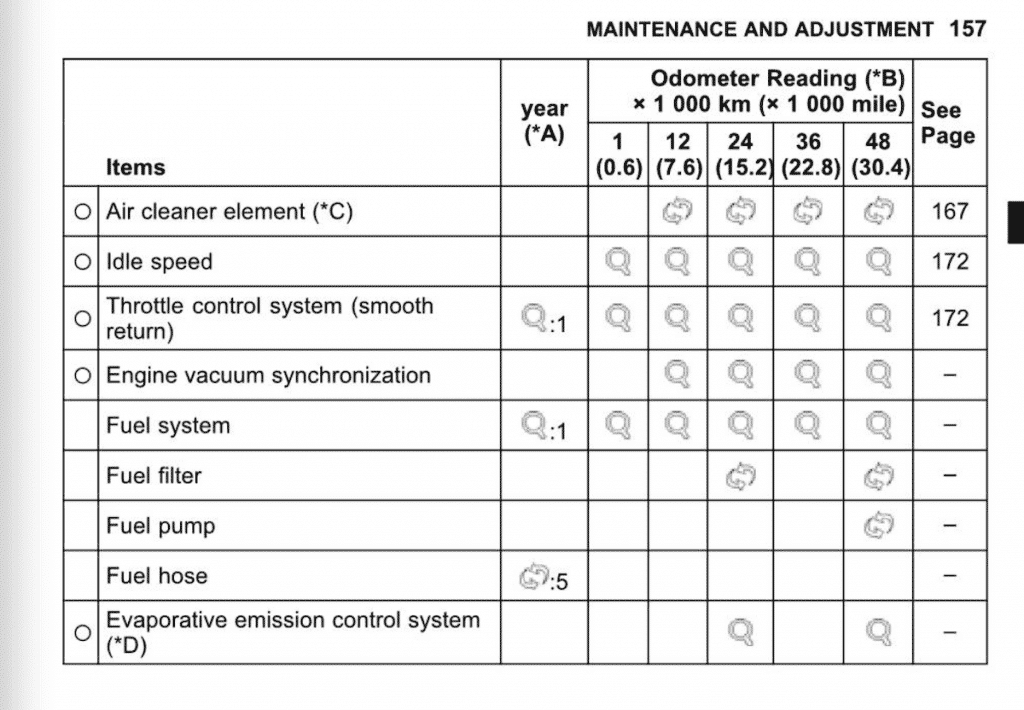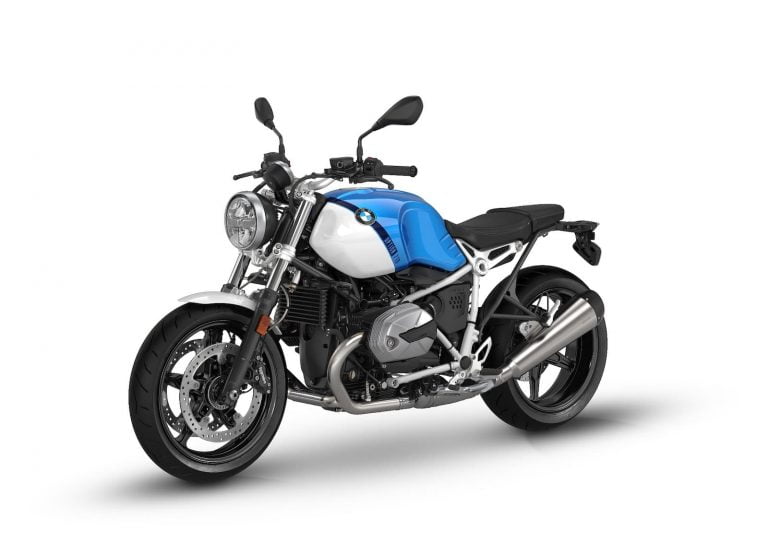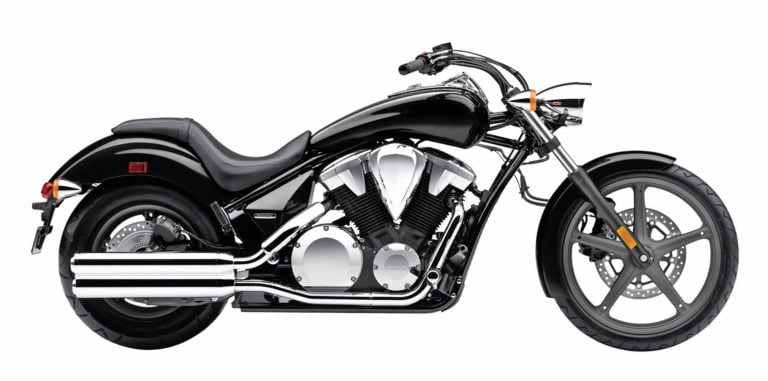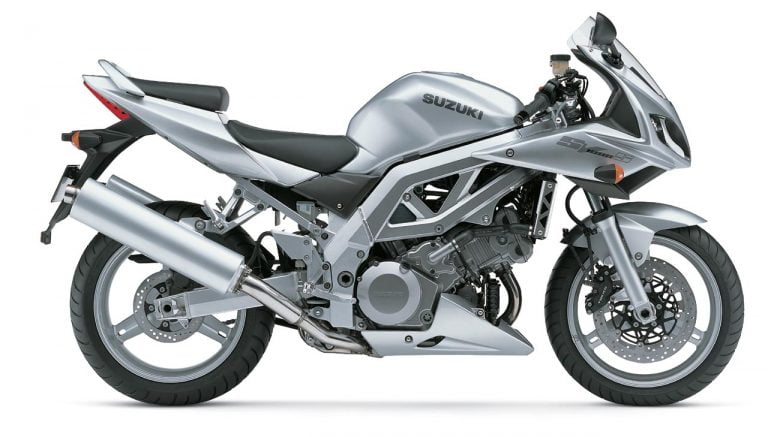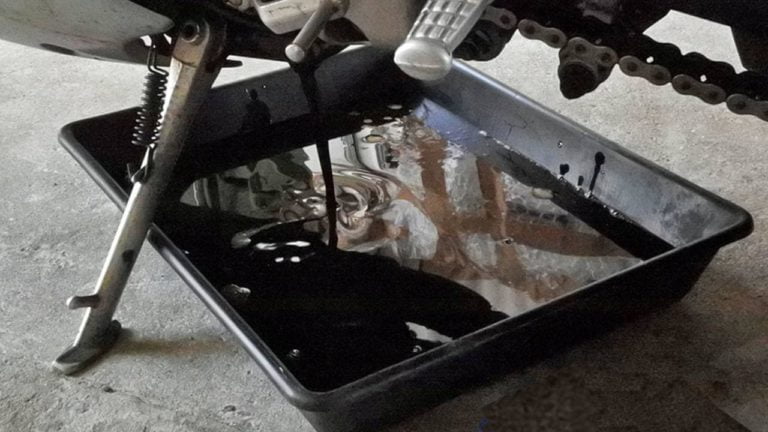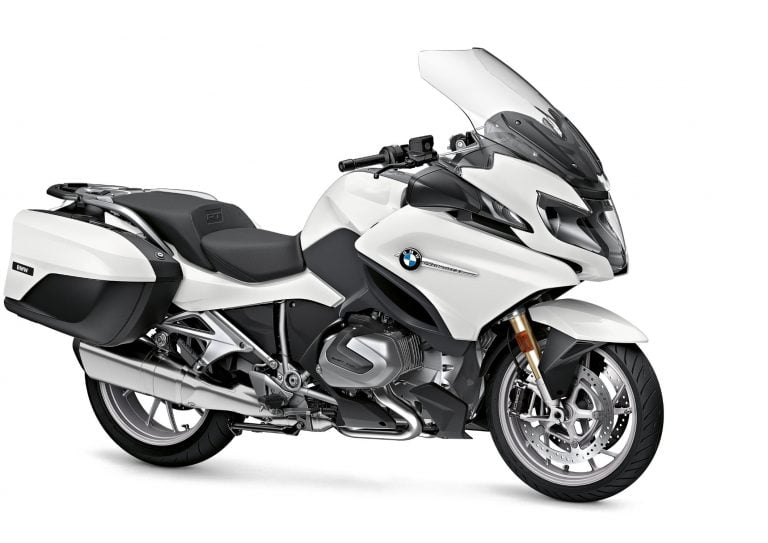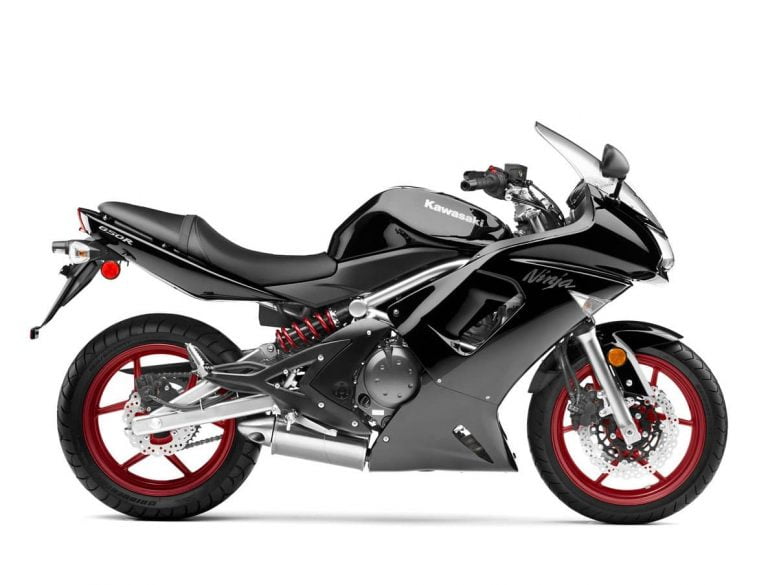Kawasaki Z H2 (base model, 2020+) Maintenance Schedule and Service Intervals
This is the maintenance schedule and service intervals for the Kawasaki Z H2, Kawasaki’s supercharged naked bike. It’s from the manual, with some reference points from service guides and parts catalogues.
The Kawasaki Z H2 is part of Kawasaki’s H2 supercharged line-up, all based on variants of a 998cc supercharged inline four-cylinder engine.
Here are the motorcycles in the Kawasaki supercharged motorcycle line-up:
- Kawasaki H2 & H2 Carbon — base model superbike
- Kawasaki H2R — a highly exclusive, track-only superbike
- Kawasaki H2 SX — Base model touring bike
- Kawasaki H2 SX SE — Touring, SE
- Kawasaki H2 SX SE+ — Touring even more SE
- Kawasaki H2 SX SE+ Performance — Enhanced touring
- Kawasaki Z H2 — Base model naked bike
- Kawasaki Z H2 SE (+ Performance) — Naked bike with high-performance suspension + brakes
In the Z H2 this engine is tuned for a peak of 147.1 kW (197 hp) at 11000 rpm, or peak torque of 137 Nm (101 ft-lb) of torque at 9500 rpm. Big numbers. It’s no lightweight though, weighing 239 kg (527 lb) — Hayabusa territory.
Still, the Z H2 is a stomper of a bike, likely to go down in the annals of history as an anomaly that somehow legislators allowed to exist on the road, before we were forced to let robots do all the driving.
Kawasaki also released the Z H2 SE, which has upgraded suspension, brakes, and a few other components.
This site has links for things like oil and spark plugs from which we earn a commission (which unfortunately nobody can save, not even us). If you appreciate this work, then please use those links. Thanks!
Service Intervals for the Kawasaki Z H2
The Kawasaki Z H2 has basic service intervals of 7600 mi / 12000 km, or annually. At every service, you change the engine oil and filter, and look over the motorcycle for a long list of checks, including checking the supercharger for axial play.
Major maintenance intervals on the Kawasaki Z H2 are quite wide, with valve clearance checks every 24000 km or 15000 mi — similar to that of other liquid-cooled four-cylinder bikes from Kawasaki (like the Ninja 1000).
The Z H2 has a hydraulic clutch as well as brake, so you can change the fluid for both at the same time.
What you need to service a Kawasaki Z H2
To service your Kawasaki motorcycle, you need some basic motorcycle maintenance tools.
Apart from that, you need the following consumables specific to your motorcycle.
| Part | Kawasaki Z H2 Spec |
|---|---|
| Engine oil | You need 0.9L of SAE 10W-40 engine oil “with API SG, SH, SJ, SL or SM with JASO MA, MA1 or MA2 rating”, e.g. Kawasaki 10W-40 Engine Oil as a basic option. Or you could use a high-grade synthetic like Motul 7100 10W-40. |
| Oil filter | Standard Kawasaki part number is 16097-009. You can also use a Hiflofiltro HF124RC. |
| Air filter | Standard Kawasaki part number is 11013-0804. You can also use a K&N KA-9915 air filter or a DNA P-K10N20-ZH2. |
| Spark plugs | The manual calls for NGK SILMAR9E9 spark plugs. |
| Brake fluid | Spec is to use DOT-4 brake fluid, e.g. Castrol DOT 4. |
| Chain maintenance | The chain needs to be lubricated quite often (especially if it gets wet or dirty). A Motul chain care kit is a good investment. |
| Brake pads | Standard Kawasaki part numbers are 43082-0194 (front) and 43082-0185 (rear). EBC part numbers are FA630HH (front) and FA266HH (rear). (See screenshot from catalogue below) |
| Grease | Use a lithium soap-based grease for all the important greasing points. |
| Battery | Dead battery? Swap it out with a Yuasa YTZ10S. |
Maintenance schedule for the Kawasaki Z H2
Below is the full maintenance schedule for the Kawasaki Z H2, adapted from the manual.
It’s simplified a little with regulatory information omitted (e.g. noting what’s an emission-related item).
The main difference in the maintenance schedule is that you have to inspect the supercharger!
Notes on letters used:
- I = Inspect
- R = Replace
- L = Lubricate
- (C) Service more frequently in severe conditions: dusty, wet, muddy, high speed, or frequent starting/stopping
| km x 1000 | 1 | 12 | 24 | 36 | 48 | |
|---|---|---|---|---|---|---|
| mi x 1000 | 0.6 | 7.6 | 15.2 | 22.8 | 30.4 | Every |
| Air cleaner element (*C) | I | I | I | I | 2 years, R | |
| Idle speed | I | I | I | I | I | |
| Throttle control system (play, smooth return, no drag) | I | I | I | I | I | Year, I |
| Engine vacuum synchronization | I | I | I | I | ||
| Fuel system | I | I | I | I | I | Year, I |
| Fuel filter | R | R | ||||
| Fuel pump | R | |||||
| Fuel hose | 5 years, R | |||||
| Evaporative emission control system (*D) | I | I | ||||
| Cooling system | I | I | I | I | I | Year, I |
| Coolant, water hoses, and O-rings | R | 3 years, R | ||||
| Valve clearance | I | I | ||||
| Air suction system | I | I | I | I | ||
| Clutch operation (play, engagement, disengagement) | I | I | I | I | I | Year, I |
| Clutch fluid, hose, and pipe | R | R | R | R | R | Year, I |
| Clutch fluid | R | R | 2 years, R | |||
| Clutch hose/rubber parts of clutch master cylinder and slave cylinder | R | 4 years, R | ||||
| Engine oil (*C) and oil filter | R | R | R | R | R | Year, R |
| Wheel bearing damage | I | I | I | I | Year, I | |
| Drive chain wear (*C) | I | I | I | I | ||
| Drive chain guide wear | I | I | I | I | ||
| Brake system | I | I | I | I | I | Year, I |
| Brake operation (effectiveness, play, no drag) | I | I | I | I | I | Year, I |
| Brake fluid (front and rear) | R | R | 2 years, R | |||
| Brake hose | 4 years, R | |||||
| Rubber parts of brake master cylinder and caliper | R | 4 years, R | ||||
| Suspension system | I | I | I | I | Year, I | |
| Steering play | I | I | I | I | I | Year, I |
| Steering stem bearing | L | L | 2 years, L | |||
| Electrical system | I | I | I | I | Year, I | |
| Spark plug | I | R | ||||
| Chassis parts | L | L | L | L | Year, L | |
| Condition of bolts, nuts, and fasteners | I | I | I | I | I | |
| Supercharger oil screen | R | R | ||||
| Supercharger impeller axial play | I | I | I | I | – |
Kawasaki Z H2 daily checks
Kawasaki also recommends the following daily checks for the Z H2. Do these with the annual service, too.
| Item | Thing to check |
|---|---|
| Fuel | Adequate supply in tank, no leaks |
| Engine oil | Oil level between level lines |
| Tyres | Air pressure (when cold), install the air valve cap Tyre wear |
| Drive chain | Slack: Every 1000 km (600 mile) Lubricate: Every 600 km (400 mile) |
| Bolts, nuts, and fasteners | Check for loose and/or missing bolts, nuts, and fasteners |
| Steering | Action smooth but not loose from lock to lock No binding of control cables |
| Brakes | Brake pad wear Brake fluid level No brake fluid leakage |
| Throttle | Throttle grip free play |
| Clutch | Clutch fluid level correct No clutch fluid leakage |
| Coolant | No coolant leakage Coolant level between level lines (when engine is cold) |
| Electrical equipment | All lights (head, city, brake/tail, turn signal, license plate, warning/indicator) and horn work |
| Engine stop switch | Stops engine |
| Side stand | Return to its fully up position by spring tension Return spring not weak or not damaged |
| Rear view mirrors | Rear view sight |
Tire sizes and pressures for the Kawasaki Z H2
The manual specifies the following tire sizes and pressures (cold).
| Tyre | Size | Tyre pressure (cold) |
|---|---|---|
| Front | 120/70 ZR 17 (58W) | 36 psi / 250 kPa (2.5 bar) |
| Rear | 190/55 ZR 17 (75W) | 42 psi / 290 kPa (2.9 bar) |
The Kawasaki Z H2 ships with Pirelli Diablo Rosso III tyres stock, though swap these out with any tyres you like (probably sport tyres).
About the Kawasaki Z H2
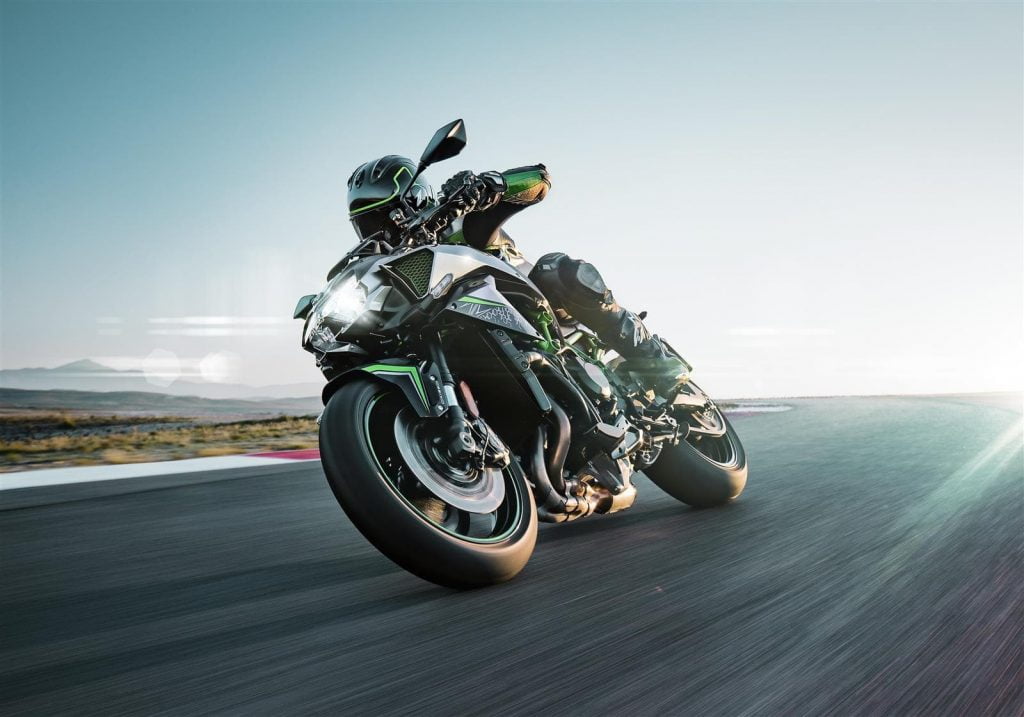
The Kawasaki Z H2 is the latest in Kawasaki’s stable of supercharged motorcycles — this time in naked/streetfighter form, with huge power and torque, and a lot of rider aids.
Basically the Kawasaki Z H2 is a “luxury” muscle bike, something like a modern B-King (which was a naked bike based on the Hayabusa’s engine).
The Z H2 is based on a 998cc supercharged liquid-cooled DOHC/16 valve inline-four engine that in the Z H2 makes 147 kW or 197 hp at 11000 rpm, a huge number that any motorcycle would be proud to be able to display. But in a naked bike, it’s even more huge!
There are of course non-supercharged motorcycles that make similar power. One example is the contemporary the Ducati Streetfighter V4, a bike that makes more power AND is lighter weight. But this isn’t a competition (is it?).
The supercharger adds some minor complication to servicing, as it has to be inspected to make sure it’s operating and that it isn’t leaking oil.
Aside from that, maintaining the Z H2 is much like maintaining any other liter bike. Valve inspections are every 24000 km (15000 mi), and done in the same way.
Riding hardware on the Z H2 is good, though not as advanced as the Z H2 SE. Front brakes are twin 320mm discs with Brembo M4.32 monobloc calipers, and front suspension is a Showa 43mm SFF BPF set-up that’s fully adjustable.
The rear wheel is on a double-sided swing-arm, as opposed to a single-sided swing-arm on the rest of the H2 series. The rear shock is a single Showa unit.
The Kawasaki Z H2 comes with the kitchen sink of rider aids, with everything from full cornering ABS, a quickshifter, launch control, and cruise control.
Despite the fact that it’s a super high power bike, the Z H2 isn’t designed to be a track bike, and Kawasaki emphasises this. Part of the reason it isn’t a good option as a track bike is the weight — it’s 239 kg (527 lb) wet.
Of course, you could definitely have a good day at the track on it… but you’d be passed by lighter bikes on most twisty tracks, and by faster bikes on most tracks with straight lines. In the meantime, RIP tyres.
Kawasaki also released an up-spec 2021 version of the Z H2 with better brakes and suspension.
Manual for the Kawasaki Z H2
The above maintenance schedule was transcribed from the manual for the Kawasaki Z H2.
You can view it on Kawasaki’s website here.
